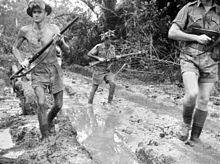Battle of Milne Bay
| date | August 25 to September 5, 1942 |
|---|---|
| place | Milne Bay / New Guinea |
| output | Allied victory |
| Parties to the conflict | |
|---|---|
| Commander | |
| Troop strength | |
| 9,000 | 2,200 |
| losses | |
|
Australia:
United States:
|
about 600 dead |
1942
Rabaul -
1. Salamaua-Lae -
Operation MO -
Coral Sea -
1. Buna-Gona -
Kokoda Track -
Milne Bay -
Goodenough -
2. Buna-Gona -
Operation Lilliput
1943
Wau -
Bismarck Sea -
I -
2. Salamaua – Lae -
Finisterre -
Cartwheel -
Bougainville -
Huon -
Dexterity / Arawe -
Bombing of Rabaul
1944 - 1945
Admiralty Islands -
Emirau -
Take Ichi convoy -
Reckless -
Persecution -
Wakde-Sarmi -
Biak -
Noemfoor -
Driniumor -
Sansapor -
Morotai -
Aitape – Wewak
The Battle of Milne Bay was a battle during the Pacific Campaign in World War II . On August 25, 1942, Japanese marines attacked an Australian base in Milne Bay on the eastern tip of New Guinea . The fighting continued until the Japanese withdrew on September 5, 1942. The battle was the first battle of the Pacific War, in which the Allied troops, the Japanese land forces were able to defeat.
The British Field Marshal William Slim, 1st Viscount Slim , who had not taken part in the battle later said about it:
“The Australian soldiers inflicted the first undoubted defeat on the Japanese in Milne Bay. Some of us may forget that of all the allies, it was the Australians who first broke the invincibility of the Japanese army. "
In fact, it was Japanese Marines of the Special Marine Landing Forces (海軍 陸 戦 隊Kaigun Rikusentai ) who attacked the Allied forces in Milne Bay. The Allies, under the command of Major General Cyril Clowes, defended a strategically important Royal Australian Air Force (RAAF) airport . The soldiers were mainly from two brigades in the Australian Army: the 18th Infantry Brigade of the Australian 7th Division and the 7th Australian Infantry Brigade , a militia unit .
The Japanese High Command deployed no more than 2,400 Marines from the 5th Kure Special Marine Landing Forces (SMLK) and the 5th Sasebo SMLK, as well as non-combatants from the 16th Marine Construction Unit. The Japanese forces were led by Commander Shojiro Hayashi . Although the Allied forces numbered around 9,000 soldiers, only about half of them were infantry. The Japanese had a significant advantage, in contrast to the Australians, they had two light tanks of the Type 95 Ha-Go . The tanks added the 2nd Company / 10. Infantry battalion suffered heavy losses and forced them to retreat. Japanese reinforcements landed on August 29th: 768 soldiers of the 3rd Kure SMLK and the 5th Yokosuka SMLK under the command of Commander Yano, who replaced Hayashi.
RAAF Squadrons No. 75 and No. 76 with their Curtiss P-40 Kittyhawk ground-attack aircraft also played an important role in the fierce fighting. Sometimes the pilots shot at the Japanese troops fighting nearby while taking off. RAAF ground personnel, including some members of other squadrons, also took part in the fighting. The 46th Engineer Regiment of the US Army Corps of Engineers , which was just expanding the Milne Bay base, also took part in the fighting.
On September 5, the Japanese high command ordered the withdrawal: According to official figures, 311 Japanese soldiers were killed and 300 were missing. The Japanese Navy was able to transport 1,318 soldiers away. The Australians suffered a loss of 534 soldiers, 161 of whom were killed or missing. The Americans also had some dead and missing to complain about.
The effects on the morale of Allied soldiers in Asia and the Pacific region were profound, especially for the other Australians who carried out rearguard operations on the Kokoda Trail , for the US soldiers who were fighting the Battle of Guadalcanal at the same time , and for Slim's soldiers of the 14th Army, which withdrew from Burma .
literature
- Clive Baker, Greg Knight: Milne Bay 1942. The Story of "Milne Force" and Japan's First Military Defeat on Land. 4th edition. Australian Military History Publications, Loftus NSW 2000, ISBN 0-646-05405-8 .
- Peter Brune: A Bastard of a Place. The Australians in Papua. Kokoda, Milne Bay, Gona, Buna, Sanananda. Allen & Unwin, Crows Nest NSW 2004, ISBN 1-74114-403-5 .
- Steven Bullard (transl.): Japanese army operations in the South Pacific Area. New Britain and Papua campaigns, 1942–43. Australian War Memorial, Canberra 2007. ISBN 978-0-9751904-8-7 ( Senshi Sōsho ).
- Chris Coulthard-Clark: The encyclopedia of Australia's battles. New edition. Allen & Unwin, Crows Nest NSW 2001, ISBN 1-86508-634-7 .
- John B. Lundstrom: The first Team and the Guadalcanal Campaign. Naval Fighter Combat from August to November 1942. New edition. Naval Institute Press, Annapolis MD 2005, ISBN 1-59114-472-8 .

